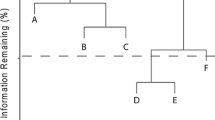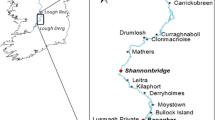Abstract
Species-rich, extensively managed grasslands are among the most threatened ecosystems in Europe. The traditional technique of meadow irrigation, formerly practised in large parts of Europe, may be a viable management option that meets both ecological and economical objectives. While studies on plant diversity of the meadow matrix exist, the role of other landscape components for biodiversity conservation is unknown. We quantify the role of irrigation and drainage ditches compared with field paths, and analysed the local and landscape plant species composition and diversity in a water-meadow landscape. The meadows are located in the river Queich catchment (Upper Rhine valley, Germany). We recorded plant species cover on 18 meadows, adjacent ditches and field paths and analysed alpha, beta and gamma diversity within and among these landscape components. Irrigation and drainage ditches were more species rich than meadows and more heterogeneous in their species composition compared with meadows and paths. Ditches contributed one-third of the landscape’s plant species numbers, habitat for wetland species and refuges for high nature value grassland species. Fertilization of the adjacent meadow had no negative impact on the ditch diversity, while well-maintained ditches were more plant species rich than ditches filled with sediments. Traditional flood meadow irrigation should be taken into account when sustainable grassland management techniques are discussed that meet economical and ecological needs. A major contribution to landscape richness arises from the ditch structures as crucial part of the traditional irrigation technique.





Similar content being viewed by others
References
Anderson MJ, Ellingsen KE, McArdle BH (2006) Multivariate dispersion as a measure of beta diversity. Ecol Lett 9:683–693
BFN Federal Agency for Nature Conservation (2014) The High Nature Value farmland indicator in Germany. https://www.bfn.de/0315_hnv+M52087573ab0.html. Accessed 13 Jan 2016
Blackstock TH, Rimes CA, Stevens DP, Jefferson RG, Robertson HJ, Mackintosh J, Hopkins JJ (1999) The extent of semi-natural grassland communities in lowland England and Wales: a review of conservation surveys 1978–1996. Gr Forage Sci 54:1–18
Buhk C, Retzer V, Beierkuhnlein C, Jentsch A (2007) Predicting plant species richness and vegetation patterns in cultural landscapes using disturbance parameters. Agr Ecosyst Environ 122:446–452
Chytrý M, Jarošík V, Pyšek P, Hájek O, Knollová I, Tichý L, Danihelka J (2008) Separating habitat invasibility by alien plants from the actual level of invasion. Ecology 89:541–1553
Connell J (1978) Diversity in tropical rain forests and coral reefs. Science 199:1304–1310
Dierschke H, Briemle G (2002) Kulturgrasland: Wiesen. Weiden und verwandte Staudenfluren. Ulmer, Stutgart
Eggenberg S, Möhl A (2009) Flora Vegetativa. Ein Bestimmungsbuch für Pflanzen der Schweiz im blütenlosen Zustand, Haupt
Ellenberg H, Weber HE, Düll R, Wirth V, Werner W (2000) Zeigerwerte von Pflanzen in Mitteleuropa. Erich Goltze, Göttingen
European Commission (2011) Our life insurance, our natural capital: An EU biodiversity strategy to 2020. Committee on the Environment, Public Health and Food Safety, Brussels
Fahrig L, Baudry J, Brotons L, Burel GF, Crist T, Fuller RJ, Sirami C, Siriwardena GM, Martin J (2011) Functional landscape heterogeneity and animal biodiversity in agricultural landscapes. Ecol Lett 14:101–112
Gabriel D, Roschewitz I, Tscharntke T, Thies C (2006) Beta diversity at different scales: plant communities in organic and conventional agriculture. Ecol Appl 16:2011–2021
Garniel A (2000) Schutzkonzept für gefährdete Wasserpflanzen der Fließgewässer und Gräben Schleswig-Holsteins. Teil C. Gräben. Landesamt für Natur und Umwelt Schleswig-Holstein, Kiel
Gaujour E, Amiaud B, Mignolet C, Plantureux S (2012) Factors and processes affecting plant biodiversity in permanent grasslands. A review. Agron Sustain Dev 32:133–160
Geertsema W, Sprangers JTCM (2002) Plant distribution patterns related to species characteristics and spatial and temporal habitat heterogeneity in a network of ditch banks. Plant Ecol 162(1):91–108
Geiger M (2008) Haardt, Weinstraße und Queichtal: Ein GeoFührer. Pollichia, Neustadt/Weinstraße
Hájek M, Hajkova P, Sopotlieva D, Apostolova I, Velev N (2008) The Balkan wet grassland vegetation: a prerequisite to better understanding of European habitat diversity. Plant Ecol 195:97–213
Hávlova M, Chytrý M, Tichy L (2004) Diversity of hay meadows in the Czech Republic: major types and environmental gradients. Phytocoenologia 43:551–567
Herzon I, Helenius J (2008) Agricultural drainage ditches, their biological importance and functioning. Biol Cons 141:1171–1183
Hobbs RJ, Huenneke LF (1992) Review: disturbance, diversity, and invasion. Implications for conservation. Conserv Biol 6:324–337
Isbell F, Calcagno V, Hector A, Connolly J, Harpole WS, Reich PB, Scherer-Lorenzen M, Schmid B, Tilman D et al (2011) High plant diversity is to maintain ecosystem services. Nature 477:199–202
Isbell F, Craven D, Connolly J, Loreau M, Schmid B, Beierkuhnlein C et al (2015) Biodiversity increases the resistance of ecosystem productivity to climate extremes. Nature 526:574–577
Isselstein J, Jeangros B, Pavlu V (2005) Agronomic aspects of biodiversity targeted management of temperate grasslands in Europe—A review. Agron Res 3:139–151
Jäger EJ (2011) Rothmaler. Exkursionflora von Deutschland. Gefäßpflanzen: Grundband. Spektrum, Germany
Janse JH, Van Puijenbroek PTM (1998) Effects of eutrophication in drainage ditches. Environ Pollut 102:547–552
Karim MN, Mallik AU (2008) Roadside revegetation by native plants: I. Roadside microhabitats, floristic zonation and species traits. Ecol Eng 32:222–237
Kark S, Van Rensburg BJ (2006) Ecotones: marginal or central areas of transition? Isr J Ecol Evol 52:29–53
Keller P (2013) Die Queichniederung—Portrait einer Landschaft. Gesellschaft für Naturschutz und Ornithologie Rheinland- Pfalz, Mainz
Kleijn D, Rundlöf M, Scheper J, Smith HG, Tscharntke T (2011) Does conservation on farmland contribute to the biodiversity decline? Review. Trends Ecol Evol 26:474–481
Konold W (2007) Die wasserabhängigen Landökosysteme. Gibt es gemeinsame Strategien von Wasserwirtschaft und Naturschutz zu deren Schutz und Erhalt? Hydrol Wasserbewirtsch 51:257–266
Kramer G (2011) Design, Construction, and Assessment of a Self-Sustaining Drainage Ditch. A thesis at the faculty of the graduate school of the University of Minnesota
Krause U, Poschlod P, Kapfer A (1993) Pflege- und Ausbaumaßnahmen an Gräben der Singener Aach-Niederung- Ihre Auswirkungen auf Vegetation und Diasporenbank. In: Bernhardt KG, Hurka H (eds) Poschlod P: Ökologie semiaquatischer Lebensräume—Aspekte der Populationsbiologie. Natur Wissenschaft, Solingen
Kunin W (1998) Biodiversity at the edge: a test of the importance of spatial ‘‘mass effects’’ in the Rothamsted Park Grass experiments. Proc Natl Acad Sci USA 95:207–212
Laird NM, Ware JH (1982) Random-effects models for longitudinal data. Biometrics 38:963–974
Leibundgut C, Kohn I (2014a) European traditional irrigation in transition part I: irrigation in times past—A historical land use practice across Europe. Irrig Drain 63:273–293
Leibundgut C, Kohn I (2014b) European traditional irrigation in transition part II: traditional irrigation in our time- decline, rediscovery and restoration perspectives. Irrig Drain 63:294–314
Londo G (1976) The decimal scale for relevés of permanent quadrats. Vegetatio 33:61–64
Manhoudt AGE, Visser AJ, De Snoo GR (2007) Management regimes and farming practices enhancing plant species richness on ditch banks. Agr Ecosyst Environ 119:353–358
Müller IB, Buhk C, Alt M, Entling MH, Schirmel J (2016a) a) Plant functional shifts in Central European grassland under traditional flood irrigation. Appl Veg Sci 19:122–131
Müller IB, Buhk C, Lange D, Entling MH, Schirmel J (2016b) b). Contrasting effects of irrigation and fertilization on plant diversity in hay meadows. Basic Appl Ecol 17:576–585
Odum EP (1953) Fundamentals of ecology. Saunders, Philadelphia
Oksanen J, Blanchet FG, Kindt R, Legendre P, O’Hara RB, Simpson GL, Solymos P, Henry M, Stevens H, Wagner H (2011) Vegan: community ecology package. R package version 1 10:631–637
Pinheiro J, Bates D, DebRoy S, Sarkar D, R Core Team (2012) nlme: linear and nonlinear mixed effects models. R package version 3.1–103, https://CRAN.R-project.org/package=nlme
R Development Core Team (2015) R: a language and environment for statistical computing. R Foundation for Statistical Computing, Vienna
Roovers P, Baeten S, Hermy M (2004) Plant species variation across path ecotones in a variety of common vegetation types. Plant Ecol 170:107–119
Rušina S, Puspure I, Gustina L (2013) Diversity patterns in transitional grassland areas in floodplain landscapes with different heterogeneity. Tuexenia 33:347–369
Sabbatini MR, Murphy KJ, Irigoyen JH (1998) Vegetation–environment relationships in irrigation channel systems of southern Argentina. Aquat Bot 60:119–133
Schirmel J, Alt M, Rudolph IB, Entling MH (2014) Effects of traditional flood irrigation on invertebrates in lowland meadows. PLoS ONE 9:e110854
Seiffert P, Kiefer H, Konold W (1994) Vegetation der Gräben im Raum Kißlegg. Institut für Landschafts- und Pflanzenökologie, Universität Hohenheim 3:25–52
Seybold S (2009) Schmeil-Fitschen. Flora von Deutschland und angrenzender Länder. Quelle and Meyer, Heidelberg
Simmering D, Waldhardt R, Otte A (2008) Steuergrößen der Pflanzenartenvielfalt in Mosaiklandschaften – eine Betrachtung auf zwei räumlichen Skalenebenen. Naturschutz und Biologische Vielfalt. Bundesamt für Naturschutz 60:67–72
Smart SM, Bunce RGH, Firbank LG, Coward P (2002) Do field boundaries act as refugia for grassland plant species diversity in intensively managed agricultural landscapes in Britain? Agr Ecosyst Environ 91:73–87
Thompson W (2004) Sampling rare or elusive species: concepts, designs, and techniques for estimating population parameters. Island Press, Washington
Tscharntke T, Klein AM, Kruess A, Steffan-Dewenter I, Thies C (2005) Landscape perspectives on agricultural intensification and biodiversity—ecosystem service management. Ecol Lett 8:857–874
Tscharntke T, Clough Y, Wander TC, Jackson L, Motzke I, Perfecto I, Vandermeer J, Whitbread A (2012) Global food security, biodiversity conservation and the future of agricultural intensification. Biol Cons 151:53–59
Van Strien AJ, Van der Burg T, Rip WTM, Strucker RCW (1991) Effects of mechanical ditch management on the vegetation of ditch banks in Dutch peat areas. J Appl Ecol 28:501–513
Wesche K, Krause B, Culmsee H, Leuschner C (2012) Fifty years of change in Central European grassland vegetation: large losses in species richness and animal-pollinated plants. Biol Cons 150:76–85
Zechmeister HG, Schmitzberger I, Steurer B, Peterseil J, Wrbka T (2003) The influence of land-use practices and economics on plant species richness in meadows. Biol Cons 114:165–177
Zelnik I, Čarni A (2008) Wet meadows of the alliance Molinion and their environmental gradients in Slovenia. Biologia 63:187–196
Zuur AF, Ieno EN, Elphick CS (2010) A protocol for data exploration to avoid common statistical problems. Methods Ecol Evol 1:3–14
Acknowledgements
This work was supported by the German Federal Environmental Foundation under Grant Number AZ 31109. Melanie Meier was supported by a scholarship within the research focus AufLand as part of the research initiative Rhineland-Palatinate financed by the Ministry for Education, Science, Further Education and Culture (MBWWK).
Author information
Authors and Affiliations
Corresponding author
Additional information
Communicated by Dr. Anne Bonis.
Electronic supplementary material
Below is the link to the electronic supplementary material.
Rights and permissions
About this article
Cite this article
Meier, M., Gerlach, R., Schirmel, J. et al. Plant diversity in a water-meadow landscape: the role of irrigation ditches. Plant Ecol 218, 971–981 (2017). https://doi.org/10.1007/s11258-017-0744-8
Received:
Accepted:
Published:
Issue Date:
DOI: https://doi.org/10.1007/s11258-017-0744-8




